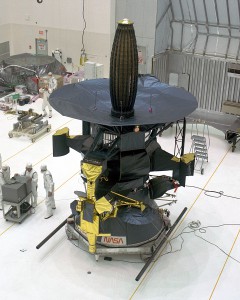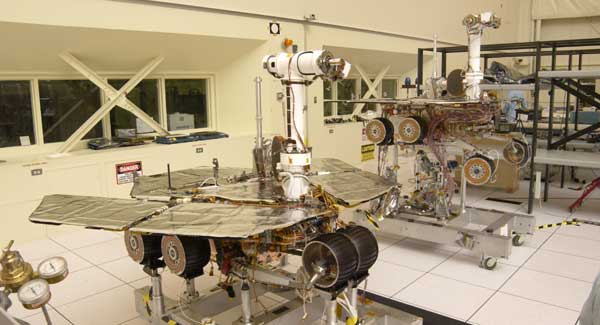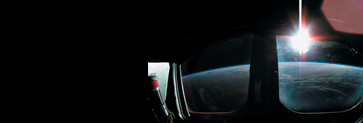By John Casani
Getting to Jupiter would be no easy matter, even in the best of conditions — so when we set our schedule, we aimed at having our Galileo spacecraft ready in time to take advantage of a window of opportunity in early 1982, when celestial conditions would favor our mission. We were assigned a berth on the 25th Shuttle mission, scheduled for February of ’82 — the first time the Shuttle would be used for a planetary mission.
The trouble was that the shuttle was still under development when that schedule was set. As time went on, the Shuttle had problems with its high-pressure turbines, thermal protection tiles, engines, and more. The early launch dates had to be scrapped. NASA Headquarters told us, “We’re going to delay your launch two years to allow more time for the Shuttle development to take place. You can slow your development accordingly.”
Right off the bat, we looked into the celestial mechanics and how they would affect us. The difficulty in launching a spacecraft to Jupiter changes on a year-to-year basis, in a cyclical pattern that repeats about every ten or twelve years. In order to achieve the velocity needed to get from low earth orbit to Jupiter, an upper stage is required in the Shuttle. For the 1982 launch the upper stage was adequate, but it could not provide the velocity we would need in 1984. This meant we would have to separate the Galileo probe from the Galileo orbiter before launch and put each of them on separate Shuttles with separate upper stages.
When we told the folks at Headquarters this, they told us, “Okay we’ll give you two Shuttle launches.”
We adjust our plans
Separating the probe from the orbiter wasn’t the real challenge. We needed to do that as the spacecraft approached Jupiter, anyway. What we needed was a probe carrier, a spacecraft to service the probe on the way to Jupiter. This required an entirely new development. We could do that, if necessary, but I worried that we couldn’t get the design completed in time and within our budget.
When I told them this at Headquarters, they said, “Well, maybe you ought to cancel this mission.” I told them that we would find a way.
We got every one lined up and working on the new development for more than a year — when someone said, “If the Centaur [an upper stage used on the Titan] could be adapted for use on the Shuttle, then we could put these two spacecraft back together.” The Centaur upper stage uses liquid hydrogen and liquid oxygen, which is much more powerful than the Inertial Upper Stage (IUS) that we were going to use. So, we started working that idea through. Some people didn’t think it would work, some thought it would take too long, and we all worried about the cost of the thing — but we kept working the problem as we explored all our options.
Finally, in early 1986 we were set to launch a large liquid oxygen/liquid hydrogen upper stage in a rocket inside the Shuttle with our spacecraft on top of it. We put everything together, and brought our spacecraft to Kennedy Space Center for the launch. Then came the Challenger accident. The Shuttle was grounded. On top of that, upper management came back to us and said that we had to be more conservative when we got back to flight. “We’ve decided that the Centaur upper stage is too risky; you can’t use it. You can use the IUS,” they told me. But it was the same story as in 1984:The old one wouldn’t get us there unless we split Galileo apart. By this time we already had the spacecraft built — so splitting it apart was out of the question. Those were the darkest days for me on this project, but I never gave up hope.
Selling the project
I knew my team would eventually find a way to get Galileo launched, and I knew what the spacecraft could deliver — but it wasn’t an easy sell. When I went in front of senior NASA management, I made an opportunity cost argument to them. I pointed out that for the increment of funding we still needed, they could, in essence, buy an entire mission. The sunk cost didn’t count because they couldn’t recover that — it was water under the bridge. So, what was the opportunity cost of that additional increment that we would need to finish? Could they buy something of more value for that same amount of money?
We were in the middle of the Cold War then, so I also used the argument that what we were doing would make a powerful statement to the Soviets. “We’re going to go to Jupiter, 500 million miles away, and we can deliver the spacecraft with an accuracy of plus or minus fifteen miles. That speaks volumes of our capabilities.” I also told them that we would get data back at higher rates than previously thought possible. In all, we could demonstrate an enormous engineering capability to the rest of the world in a non-threatening way. For if we could send something like this to Jupiter, think of what we could do on Earth.
I described how compelling the mission was in terms of the science return we could expect. I reminded them that we knew without a doubt that that our target was rich because Voyager had told us that. We knew that we had the capability to go into orbit around Jupiter and stay there for several years and do multiple flybys, close flybys — the equivalent of ten or more Voyager missions. There was the opportunity cost again, you see? You could do with this one spacecraft what it would have taken ten, or even twenty Voyagers. I spoke to people on Capitol Hill to relay this message. The project manager doesn’t do that anymore; Headquarters does. But even at the time, I got to do things not usually done because a lot of people had written our project off. The people on the Hill listened. In the end, they supported us and gave us the money to keep going.
And we regroup
Galileo was built; we just needed to find a way to get it to Jupiter. I engaged everyone in the project to think this thing through. I asked them, “What are other ways to approach this launch?”
First, we looked at using a Russian launch vehicle that might be capable of launching our spacecraft. Though relationships with Russia still weren’t all that great at that point, we talked to them and found out what it would take. They were willing to discuss the idea further with us, but we decided it was too marginal. We took a look at doing enhancements to other launch vehicles, but saw that wouldn’t work, either.
People tried to tell me again that this mission was never going to happen. I never accepted that. I just kept my team going. People said to me, “Okay that’s it.” I just shook my head. They said, “How do you know that’s not it? You haven’t found a solution.” All I told them was, “Well, we haven’t concluded that there isn’t a solution.”
In order to design our original mission we had developed the mathematics and trajectory design tools to do multiple flybys of Jupiter’s moons. So when we found ourselves without a launch vehicle, we decided to put that technology to use and see if we could apply it to solving the problem of getting to Jupiter. My people sketched out all sorts of approaches to the problem. Nothing was working.
Still, I kept them focused on the excitement of the science we hoped to return, and kept them working on the problem. My message to them was, “This is a good mission. Keep your eye on the ball. Don’t look down. Look up. Together, we’ll find a way out of this.” I had to keep doing that not only with our people here, but with Congress and with the people at Headquarters.
Then — I’ll never forget the day — I was sitting in my office one morning when an engineer walked into my office. He said, “You probably won’t go for this, but I think I found a way to get to Jupiter.”
He went up to the white board and sketched out a trajectory. He said, “Here is what we can do. Instead of going out this way to Jupiter, we’ll start off going to Venus. We’ll do a gravity assist at Venus to add a bit of velocity. We’ll come back to the Earth and pick up more velocity. We’ll go out past the asteroids and then we’ll come back to the Earth a second time and then back to the asteroid belt. It will take four years, but we’ll be ready to go to Jupiter.”
I looked at this guy for a moment, thinking about the implications. Before I could say anything he said, “Well, I didn’t think you would like it.”
“Are you kidding?” I asked. “I love it. Let’s do it.” He said he was worried about the changes we would need to make the spacecraft capable of handling the increased thermal environment near Venus and of handling the new telecommunication geometry that would be required. “We’ll take care of that part,” I said.
“You just go figure out this trajectory.” He and a couple other guys went off and did a more complete analysis and design.
We would add about four years to the flight with the time spent around Venus and the two passes by Earth. Instead of getting to Jupiter in the two years and nine months we had planned on, it would take about six years.We had used trajectories before to gain velocity on space missions, but we had never attempted a “triple” like this one. It would mean trading trip time for launch energy, and that had clear disadvantages. But it looked as though we would only have to make moderate adjustments to our spacecraft design.
That was good enough for me. We would use the trajectory to get to Jupiter.
A new phase
I had been on the project for ten years, three months, and two days, when my boss was promoted and they offered me his job overseeing all the flight projects at the Jet Propulsion Laboratory. It was hard to leave the project at that point, but I did get to stay involved and see it launched in 1989 — even though I was no longer the project manager.
I watched with pride as our mission flew the trajectory, delivering valuable science data for Venus, the Earth and moon, and the asteroid belt. Finally, Galileo headed for its rendezvous with Jupiter and its moons — and arrived in December 1995. Its eight years and 35 orbits around Jupiter turned out to be everything we hoped it would be. Tenacity certainly has its rewards. We put Galileo to sleep last year. A lot of people were sorry to see it go. You know, I didn’t think of it that way. It was out of fuel, and there was nothing much more we could do with it. It was going to die one way or another. We decided to send it on a collision course with Jupiter, sending us back data from the planet’s magnetic field as it went. We threw a farewell party on Galileo’s last day and we celebrated its success.
Galileo gave us more science than we could have hoped for. T.S. Eliot once speculated that the world would end “not with a bang but a whimper.” Well, we decided that Galileo deserved to go out with a bang.
Lessons
- A project team takes its lead from the project manager. When managers make clear their own commitment to and belief in their projects, they empower their teams to overcome problems that crop up.
- An important part of any project manager’s job is to “sell” a project — not just to get the project off the ground but to keep the project alive when surmountable obstacles arise. That “selling” may require creative thinking to frame the project in a way that makes its value more apparent to project sponsors.
Question
Under what circumstances might a project manager decide that a project should no longer be “sold”?
Search by lesson to find more on:
- Challenging the Status Quo
- Leadership











